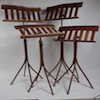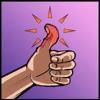Hi everyone,
I have a question that has been bothering me for some time; have researched it-still stumped.
Bandsaw blade tension gage.
I know about Young's modulus of elasticity coefficient (new word), and it is a lot of math.
The deal is...........you put the two arms of any size/thickness/width blade b/t the two arms of the gage, crank up the tension, and the gage measures the amount of stretch of the blade.
Of course, if you stretch a flimsy 1/4" blade 0.003" that could be, say, 10K psi
If you stretch a 1" blade 0.003", that would take a lot more tension, of course, and may represent 25 psi
The psi numbers above are intended for illustrative purposes only.
So..........if the tension gage senses the same amount of distance moved between it's two arms in each blade-how does it know that one blade is 1/4" and the other is 1", and much more tension is there?
If you had to take the reading and consult a table supplied by the manufacturer, that would make more sense, as the main variables are the cross section of the blade, then you have the material/steel that is being stretched. But there is no such table..........just the distance. What am I missing here?
As always, thank you!




 Reply With Quote
Reply With Quote






